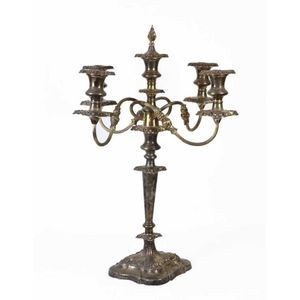Belle Epoque Bronze & Frosted Glass Chandelier
You must be a subscriber, and be logged in to view price and dealer details.
Subscribe Now to view actual auction price for this item
When you subscribe, you have the option of setting the currency in which to display prices to $Au, $US, $NZ or Stg.
- Foliate - Decorated with leaves or leaf-like forms.
- Bronze - An alloy of copper and tin, traditionally in the proportions of about 9 parts of copper to 1 part of tin.
The discovery of bronze in Western Asia in the 4th century enabled people to create metal objects which were superior to those previoulsy possible because of its strength and hardness, and it has been used throughout the world for weapons, coins, tools, statuary and other decorative items.
It is very fluid in a molten state, and its hardness, strength when set, and non-corrosive properties makes it most suitable for casting sculpture. - Belle Epoque - The Belle Époque, also known as the "Beautiful Era," was a period in European history that lasted from the late 19th century to the outbreak of World War I in 1914. The term is most commonly associated with France, but is also used to refer to the same period in other countries, particularly in Western Europe and Latin America.
During the Belle Époque, Europe experienced a time of great prosperity and cultural, artistic, and scientific advancements. It was an era of peace and optimism, characterized by industrial growth, urbanization, and new technologies such as electricity, automobiles, and the telephone. The period is also associated with a flourishing of art and culture, particularly in the fields of literature, music, and the visual arts. - Circa - A Latin term meaning 'about', often used in the antique trade to give an approximate date for the piece, usually considered to be five years on either side of the circa year. Thus, circa 1900 means the piece was made about 1900, probably between 1895 and 1905. The expression is sometimes abbreviated to c.1900.
This item has been included into following indexes:
Visually similar items

A decorative wrought iron and frosted glass chandelier by Degue, early 20th century, signed, a trio of square section stems with vegetal motifs to a boss decorated with trailing pierced vine leaves and supporting a frosted dish with a pleated or fan motif,

A sterling silver 5 branch table candelabra mid 20th century, hallmarked Birmingham. Note: the top sconce lifts off and can be used as a singular candlestick. Height 53 cm

A contemporary Venetian four branch glass chandelier with a central dark green glass column and four articulated stylised flower and leaf branches. Height 62 cm. Width 850

A contemporary Venetian four branch glass chandelier with a central dark green glass column and four articulated stylised flower and leaf branches. Height 62 cm. Width 850
